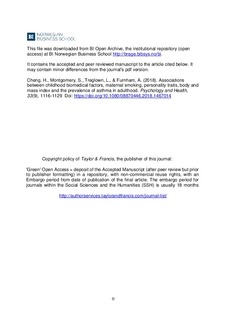Associations between childhood biomedical factors, maternal smoking, personality traits, Body and Mass Index and the prevalence of asthma in adulthood
Journal article, Peer reviewed
Accepted version
Permanent lenke
http://hdl.handle.net/11250/2562068Utgivelsesdato
2018Metadata
Vis full innførselSamlinger
- Publikasjoner fra CRIStin - BI [1015]
- Scientific articles [2181]
Sammendrag
Objective: The study set out to investigate socio-economic, biomedical, health and behavioural and psychological factors in childhood and adulthood associated with the prevalence of asthma in adulthood, drawing data from The National Child Development Studies (NCDS), a birth cohort in the UK.
Design: The National Child Development Study, a nationally representative sample of 17,415 babies born in Great Britain in 1958 and followed up at 7, 11, 33 and 50 years was used.
Main Outcome Measure: The prevalence of asthma at age 50 was the outcome measure. The analytic sample consists of 5118 participants with complete data on a set of measures at birth, at ages 7, 11, 33 and 50 years.
Results: Using logistic regression analyses, results showed that childhood asthma (OR = 6.77: 4.38–10.48, p < .001) and respiratory symptoms (OR = 1.83: 1.18–2.86, p < .01), maternal smoking during pregnancy (OR = 1.26: 1.00–1.59, p < .05), Body and Mass Index (BMI) (OR = 1.03: 1.02–1.05, p < .001), traits Neuroticism (OR = 1.13: 1.01–1.21, p < .05) and Conscientiousness (OR = 0.76: 0.76–0.96, p < .01), as well as sex (OR = 1.49: 1.15–1.94, p < .001) were all significantly associated with the prevalence of asthma in adulthood.
Conclusion: The study shows that both childhood and adulthood psychological and sociological factors are significantly associated with the prevalence of asthma in adulthood, though more work need to be done in this area.
